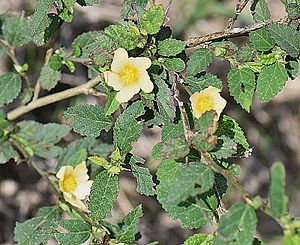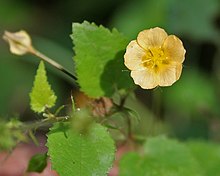Sida (genus)
| Sida | ||||||||||||
|---|---|---|---|---|---|---|---|---|---|---|---|---|

Sida spinosa |
||||||||||||
| Systematics | ||||||||||||
|
||||||||||||
| Scientific name | ||||||||||||
| Sida | ||||||||||||
| L. |
The plant genus Sida belongs to the mallow family (Malvaceae). The 125 to 150 species occur worldwide, but mainly in the tropics and subtropics . There are species in Africa, Asia, Australia, North to South America, and on the Pacific Islands, but about two-thirds of the species are found in the New World .
description
Appearance and leaves
Sida TYPES grow as annuals or perennial herbaceous plants , semi-shrubs or shrubs , to reach stature heights of about 2 meters. Most of the above-ground parts of plants have star hairs , simple hairs and / or glandular hairs. The alternate leaves are arranged in a petiole and a leaf blade. The simple leaf blades are rarely lobed and mostly toothed. There are no extra-floral nectaries on the leaves . The stipules are thread-like or narrowly lanceolate.
Inflorescences and flowers

The flowers are solitary or in twos, laterally or almost terminally, often in lateral or terminal racemose or paniculate , rarely in golden or clustered inflorescences . There is no secondary chalice.
The hermaphroditic, five-fold flowers have a double flower envelope . The five sepals are fused bell-shaped or cup-shaped. The five petals are only slightly fused at their base. The color of the petals ranges from mostly yellow, rarely white, pink to purple to more or less orange, sometimes with a dark center. In the subfamily Malvoideae, the many stamens have grown together to form a tube surrounding the pistil . The stamen tube is fluffy hairy or bald and ends with many anthers. Five to ten carpels are an above-permanent, five to zehnkammerigen ovary grown. There is only one hanging ovule in each ovary chamber . There are five to ten stylus branches, each ending in a cephalic scar.
Fruits and seeds
The more or less disc-shaped or spherical split fruit disintegrates into usually five to ten (4 to 14) partial fruits. The partial fruits are smooth or carved, sometimes partially membranous, usually beaked, often with one or two bristles, often tiny, downy covered with star hair. When ripe, the partial fruits open or remain closed. There is a seed in each partial crop. The seeds are smooth or they sometimes show tiny hairs around the hilum .
Systematics
The generic name Sida was first published in 1753 by Carl von Linné in Species Plantarum , 2, pp. 683-686. The generic name Sida was taken over by Carl von Linné from the writings Theophrastus von Eresos , who used it for Nymphaea alba . Britton & Brown established the species Sida alnifolia L. as the lectotype in 1913 .
The genus Sida belongs to the tribe Malveae in the subfamily of Malvoideae within the family of Malvaceae . Sida is a relatively large, heterogeneous, paraphyletic genus, from which a number of new genera: Allosidastrum , Bastardiopsis , Billieturnera , Dendrosida , Krapovickasia , Malvella , Meximalva , Rhynchosida , Sidastrum and Tetrasida have been spun off. A synonym for Sida L. is Pseudomalachra (K.Schum.) Monteiro .

Selected species
There are around 125 to 150 types of Sida :
- Sida acuta Burm. f. : Its range includes Asia, North, Central and South America. In Africa, Australia and the islands in the Pacific it is a neophyte.
- Sida alnifolia L .: Its range extends from India, Sri Lanka, Thailand, Indonesia, Malaysia, the Philippines, Taiwan and China to Mauritius and Reunion.
- Sida angustifolia Mill.
- Sida calyxhymenia J. Gay ex DC. : It was described from Australia.
- Sida cardiophylla ( Benth. ) F. Muell. : It was described from Australia.
- Sida chinensis Retzius : It occurs only in Hainan , Yunnan and Taiwan.
- Sida ciliaris L .: It occurs from Texas, Florida and the islands of the Caribbean to Argentina and Paraguay.
- Sida cleisocalyx F. Muell. : It was described from Australia.
- Sida clementii Domin : It was described from Australia.
- Sida cordata (Burm. F.) Borss. Waalk. : It occurs from Pakistan and India to Taiwan and the Philippines and is a neophyte in the Caribbean.
- Sand mallow or Indian mallow ( Sida cordifolia L. ): It occurs in Africa, Asia and South America and is a neophyte in Australia, North and Central America.
- Sida cordifolioides K.M.Feng : This endemic occurs in Hunan only in Yongshun.
- Sida cryphiopetala F. Muell. : It was described from Australia.
- Sida echinocarpa F. Muell. : It was described from Australia.
- Sida elliottii Torr. & A.Gray : It is found in the southeastern United States, eastern Mexico, and Guatemala.
- Sida fallax Walp. : It occurs in Oceania and especially in Hawaii.
- Sida glabra Mill .: It occurs from Mexico and the islands of the Caribbean to northern South America.
- Sida glomerata Cav. < : It occurs from Nicaragua and the islands of the Caribbean to Peru and Paraguay.
- Sida hermaphrodita (L.) Rusby : It occurs in the eastern United States.
- Sida intricata F. Muell. : It was described from Australia.
- Sida javensis Cav. : It is widespread in Taiwan, Indonesia, Malaysia, and the Philippines.
- Sida kingii F.Muell. : It was described from Australia.
- Sida linifolia Juss. ex Cav. : It occurs in topical Africa and from Mexico and Central America to Peru and Uruguay.
- Sida lomageiton Ulbr. : It was described from Peru.
- Sida mysorensis Wight & Arnott : Their distribution area ranges from India, Laos, Cambodia, Thailand, China, Vietnam to Indonesia and the Philippines .
- Sida orientalis Cav. : It occurs in Taiwan and southern Yunnan .
- Sida quinquevalvacea J.L.Liu : It occurs at altitudes between 1100 and 1600 meters only in southwestern Sichuan .
- Sida phaeotricha F. Muell.
- Sida physocalyx F. Muell. : It was described from Australia.
- Sida rhombifolia L .: It occurs in Asia, Africa, in North, Central and South America.
- Sida spenceriana F. Muell. : It was described from Australia.
- Sida spinosa L. (Syn .: Sida alba L. ): It occurs in Africa, Sri Lanka, Australia, in North, Central and South America.
- Sida subcordata Spanoghe : Its range extends from India, Indonesia, Laos, Myanmar , Thailand, China to Vietnam.
- Sida szechuensis Matsuda : It occurs at altitudes between 300 and 1800 meters in Guangxi , Guizhou , Sichuan , Yunnan.
- Sida trichopoda F. Muell.
- Sida urens L .: It occurs in tropical Africa, Madagascar, Mexico, Central and South America.
- Sida yunnanensis S.Y.Hu : It occurs in Guangdong , Guangxi, Guizhou, Sichuan and Yunnan.
use
The so-called giant mallow Sida hermaphrodita is harvested as a renewable raw material ; it has a similar ash value and a comparable calorific value in terms of weight as wood .
swell
- Ya Tang, Michael G. Gilbert & Laurence J. Dorr: Malvaceae in der Flora of China , Volume 12, 2007, p. 270: Sida - Online. (Section description, systematics and dissemination)
Individual evidence
- ^ Sida at Tropicos.org. Missouri Botanical Garden, St. Louis
- ↑ a b c d e f g h i j k l m n o p The genus Sida at GRIN - Taxonomy for Plants .
- ↑ Jennifer A. Tate, Javier Fuertes Aguilar, Steven J. Wagstaff, John C. La Duke, Tracey A. Bodo Slotta & Beryl B. Simpson: Phylogenetic relationships within the tribe Malveae (Malvaceae, subfamily Malvoideae) as inferred from ITS sequence data . , In: American Journal of Botany , Volume 92, 2005, pp. 584-602 PDF.
- ↑ a b c d e f g h i j Ya Tang, Michael G. Gilbert & Laurence J. Dorr: Sida Linnaeus. - Same text online as the printed work , In: Wu Zheng-yi, Peter H. Raven, Deyuan Hong (Ed.): Flora of China. Volume 12: Malvaceae. Science Press and Missouri Botanical Garden Press, Beijing and St. Louis 2010
- ^ Paul A. Fryxell, Steven R. Hill: Sida Linnaeus . In: Flora of North America, vol. 6. [1] .
- ↑ badische-zeitung.de, March 13, 2013, Sabine Model: Energy from inconspicuous plants (March 14, 2013)
Web links
- Gallery at malvaceae.info.
- Sida . In: U. Brunken, M. Schmidt, S. Dressler, T. Janssen, A. Thiombiano, G. Zizka: West African plants - A Photo Guide. Senckenberg Research Institute, Frankfurt am Main 2008. (English)





